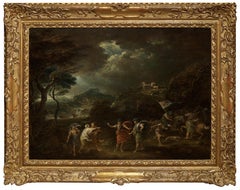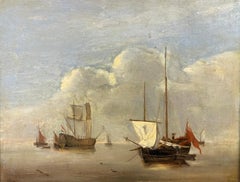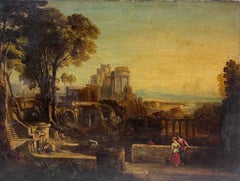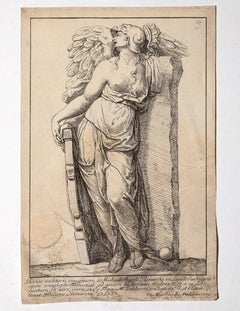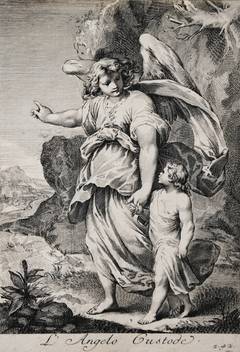Francesco Zuccarelli Art
to
1
Overall Width
to
Overall Height
to
1
1
1
1
1
1
1
1
1
2
9,961
2,752
1,376
1,372
1
Artist: Francesco Zuccarelli
Macbeth and the Three Witches a Painting on Panel by Francesco Zuccarelli
By Francesco Zuccarelli
Located in PARIS, FR
This painting, created during Zuccarelli's stay in England, represents the decisive moment when Macbeth, together with Banquo, meets the three witches who announce that he will be Ki...
Category
1760s Old Masters Francesco Zuccarelli Art
Materials
Oil, Wood Panel
Related Items
Shipping in Calm Waters, 18th Century Dutch Oil on Wood Panel, Man o War
Located in Cirencester, Gloucestershire
Shipping in Calm Waters
Dutch School, 18th century
oil painting on wood panel
panel: 10 x 12.75 inches
framed: 14 x 17 inches
condition: very good, minor evidenc...
Category
18th Century Old Masters Francesco Zuccarelli Art
Materials
Oil, Wood Panel
$2,094 Sale Price
30% Off
H 14 in W 17 in D 1 in
Fine 1800's Italian Grand Tour Oil Painting Figures before Classical Buildings
Located in Cirencester, Gloucestershire
The Arcadian View
Italian School, circa 1800
Grand Tour subject
oil on canvas, unframed
canvas : 12 x 16 inches
provenance: private collection, UK
condition: very good and sound cond...
Category
Early 1800s Old Masters Francesco Zuccarelli Art
Materials
Oil
$2,089 Sale Price
30% Off
H 12 in W 16 in
Martyrdom of Saint Stephen- Painting attr. to Vincent Adriaenssen- 17th Century
Located in Roma, IT
Landscape with martyrdom of Saint Stephen is an old master artwork realized in 17th century.
Mixed colored oil painting on canvas.
Includes coeval gilded frame cm. 148x196.
The artwork is attributed to Vincent Adriaenssen called il Manciola (Antwerp, 1595 - Roma, 1675)
Among the painters who worked in the first half of the seventeenth century it is possible to indicate only the Neapolitan Scipione Compagno (1624-1680) as the author of scenes of martyrs set within a landscape or a view such as, for example, the Martyrdom of Saint Stefano recently hesitated at the Ansorena in Madrid on June 16, 2021. It should be noted, however, that the landscape represented in the painting examined here, characterized by luxuriant vegetation, meticulously represented "in the Flemish style", shows differences with the typical settings of the paintings di Compagno, characterized above all by urban views, visionary architectures or rather arid vegetation. Even the refined figures, so elongated and lanky, represented in our painting, in particular the group of knights in the foreground on the right, are not reflected in the production of the Neapolitan painter. These elements, to which we add the depiction of the Eternal Father amidst the clouds and the detail of the dog in profile in the foreground, instead recall a painter mainly known as a battle soldier, but who was also the author of many works depicting episodes from ancient Rome set within luxuriant landscapes, or rather Vincent Adriaenssen known as Manciola, a painter from Antwerp whose figure has been shed light thanks to recent studies. The group of horsemen represented to the right of the examined painting is, in fact, comparable with other groups on horseback present in numerous works by Manciola such as, for example, in the Triumph of Caesar (Rome, Babuino, 23-03-2010; formerly Florence, Collection Privata, 2006), while similar elongated and somewhat lanky figures, dressed in red, yellow, blue and white, can be found in the three paintings conserved at the Cassa di Risparmio di Pesaro, which in the past were erroneously attributed to the Umbrian painter Francesco Allegrini...
Category
17th Century Old Masters Francesco Zuccarelli Art
Materials
Oil
$38,049
H 49.22 in W 68.9 in D 0.04 in
17th Century Classical Oil Painting - Diana With Her Attendants in a Grotto
By Abraham van Cuylenborch
Located in London, GB
Abraham van CUYLENBROCH (1620-1658)
Diana With Her Attendants in a Grotto
1651
signed
oil on panel
12.2 in x 15.7 inches, inc. frame;
31 x 40 cm
Provenance:
Sale of Sotheby's Lo...
Category
17th Century Old Masters Francesco Zuccarelli Art
Materials
Oil
18th century English marine Battle scene between Dutch and British warships
By Francis Swaine
Located in Woodbury, CT
Attributed to Francis Swaine (British, 1725–1782)
Naval Engagement at Sea, 18th century
Oil on panel
In this evocative seascape, a cluster of ships—flags raised, cannons fired—conve...
Category
1760s Old Masters Francesco Zuccarelli Art
Materials
Oil, Wood Panel
17th century Flemish seascape - Stormy Sea with Merchant Vessels and dolphins
By Bonaventura Peeters the Elder
Located in Aartselaar, BE
Bonaventura Peeters the Elder (1614–1652) attr., Stormy Coastal Scene with Merchant Vessels, Galliot, and Dolphins
Framed by rugged cliffs and illuminated under a dark, swirling sk...
Category
17th Century Old Masters Francesco Zuccarelli Art
Materials
Oil, Panel
$7,728
H 16.15 in W 27.76 in
Landscape with Gentleman on Horseback and Peasant Woman Receiving Alms
By Philips Wouwerman
Located in Stockholm, SE
Workshop / Circle of Philips Wouwerman (1619-1668)
Landscape with Gentleman on Horseback and Peasant Woman Receiving Alms
oil on oak panel
12.40 x 14.17 inches (31.5 x 36 cm)
wit...
Category
17th Century Old Masters Francesco Zuccarelli Art
Materials
Oak, Oil, Wood Panel
$17,835
H 12.41 in W 14.18 in
Fine 17th Century Dutch Old Master Oil on Panel Angelic Visitation to Figures
By Rembrandt van Rijn
Located in Cirencester, Gloucestershire
The Angelic Visitation
Dutch School, mid 17th century
circle of Rembrandt (Dutch 1606-1669)
oil on wooden panel, framed in faux tortoiseshell style frame.
framed: 25 x 28.75
painting...
Category
17th Century Old Masters Francesco Zuccarelli Art
Materials
Oil, Wood Panel
$12,160 Sale Price
30% Off
H 25 in W 28.75 in D 1 in
Antique English 19th century marine scene
By William Anderson
Located in Woodbury, CT
Outstanding English late 18th / early 19th century marine scene by one of Britain's best known and sought after painters.
William (or Wiliam) Anderson (1757 – 27 May 1837) was a Scottish artist specializing in maritime and patriotic themes. He was well-regarded for his detailed and accurate portraits of ships under sail, exhibiting his works annually in London between 1787 and 1811 and then occasionally until 1834. Anderson influenced other artists, notably John Ward and others of the Hull school.
Anderson's early life is obscure, but he is known to have trained as a shipwright before moving to London to become a maritime painter when he was about 30. His training served him well as a painter, providing "a practical nautical knowledge" of his subjects. He earned a reputation for "accuracy and refinement of detail" and was admired for his bright, clear colours. He worked in both oils and watercolours.
He based his style on that of well-known Dutch maritime...
Category
1810s Old Masters Francesco Zuccarelli Art
Materials
Oil, Wood Panel
$5,167 Sale Price
35% Off
H 8 in W 10 in
The peace of your nights descends into their thoughts
Located in Genève, GE
Work on paper mounted on wood
35.5 x 45.5 x 2 cm
Category
Late 18th Century Old Masters Francesco Zuccarelli Art
Materials
Oil
Flemish 17th c., Allegory of war and peace, circa 1630, by Adriaen van Stalbemt
Located in PARIS, FR
Adriaen van Stalbemt (Antwerp, 1580-1662)
Allegory of Peace and War, circa 1620-1630
Oil on oak panel: h. 49.5 cm, l. 73.2cm (19.29 x 28.74 in)
Giltwood ...
Category
Early 17th Century Old Masters Francesco Zuccarelli Art
Materials
Oil, Panel
$25,564
H 25.2 in W 36.22 in
Fine Antique Italian Oil Cannaregio Canal Venice Busy Figurative Scene
Located in Cirencester, Gloucestershire
View on the Cannaregio Canal, Venice
Italian School, 19th century, after Francesco Guardi, Italian 1712-1793
oil on panel
Painting: 8 x 10 inches
condition: overall very sound, with ...
Category
19th Century Old Masters Francesco Zuccarelli Art
Materials
Oil
Antique Italian SchoolFine Antique Italian Oil Cannaregio Canal Venice Busy Figurative Scene, 1800's
$2,284 Sale Price
30% Off
H 8 in W 10 in D 1 in
Previously Available Items
After Michelangelo - Original Etching by Francesco Zuccarelli - 1750
By Francesco Zuccarelli
Located in Roma, IT
After Michelangelo Buonarroti is an original Modern artwork realized by Francesco Zuccarelli (Piticciano, 1702 - Florence, 1779).
Original Etching on paper.
Inscripted on plate on the lower margin.
Fair conditions: some foxings spots are present on the lower part.
Beautiful artwork that depicts a huge sculpture that is from a drawing realized by the great master Michelangelo Buonarroti. The work is an excellent example of the typical work of Michelangelo that realized several sculptures and drawings of big dimensions.
This work has been realized by the Italian painter Francesco Zuccarelli (Pitigliano, 1702 - Florence, 1788). He was an Italian painter of the Rococo period. He was initially a painter of historical subjects inspired by the knowledge of painting by Claude Lorrain, a Seventeenth-century French painter who lived in Rome who was a master of this genre together with his compatriot, but more scenographic, Nicolas Poussin. Moving to Venice, Zuccarelli turned to Arcadian painting...
Category
1750s Francesco Zuccarelli Art
Materials
Etching
H 8.08 in W 5.52 in D 0.04 in
L'Angelo Custode (The Guardian Angel)
By Francesco Zuccarelli
Located in Saint Augustine, FL
An original copper plate engraving on laid paper by Italian artist Francesco Zuccarelli (1702-1788) titled "L'Angelo Custode (Guardian Angel), 1742.
Francesco Zuccarelli, (1702–1...
Category
18th Century and Earlier Old Masters Francesco Zuccarelli Art
Materials
Engraving
Francesco Zuccarelli art for sale on 1stDibs.
Find a wide variety of authentic Francesco Zuccarelli art available for sale on 1stDibs. You can also browse by medium to find art by Francesco Zuccarelli in paint, oil paint, panel and more. Much of the original work by this artist or collective was created during the 18th century and is mostly associated with the Old Masters style. Not every interior allows for large Francesco Zuccarelli art, so small editions measuring 23 inches across are available. Customers who are interested in this artist might also find the work of Sir Godfrey Kneller, Jan Frans van Bloemen (Orizzonte), and Giulio Di Sotto. Francesco Zuccarelli art prices can differ depending upon medium, time period and other attributes. On 1stDibs, the price for these items starts at $5,385 and tops out at $55,000, while the average work can sell for $30,192.
